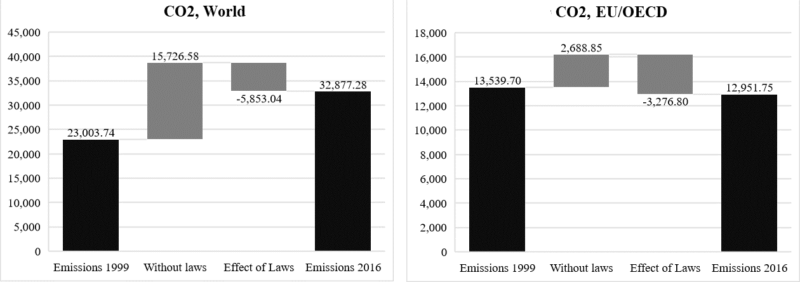The impact of current climate policies on greenhouse gas emissions
Posted on 13 Jul 2020 in Commentary
Shaikh Eskander and Sam Fankhauser share the results of their new study that shows the carbon savings made due to climate change laws and policies over the last two decades and call on policymakers to adopt identified good practice so that environmental legislation leads to deeper cuts in greenhouse gas emissions.
The global response to climate change has been inadequate, but not as feeble as many people think. The body of climate change laws and policies passed since 1999 has reduced global carbon dioxide emissions over those 20 years by around 38 gigatonnes (Gt). A further 4 GtCO2e were avoided in cumulative emissions of other greenhouse gases, including methane. Together these savings add up to almost one year’s worth of global greenhouse gas emissions. In the year 2016, annual CO2 emissions would have been 5.9 GtCO2 higher without any climate action. This is the same as adding another United States to the emissions tally.
These are the results of our latest paper, which has just been published in Nature Climate Change. The numbers are, of course, estimates, not actual measurements. Defining the counterfactual emissions trajectory – the path emissions would have followed without any climate policies – is not an exact science.
We approached the task with statistical techniques. We constructed a panel of climate change legislation in 133 countries over the 18-year period 1999 to 2016, using publicly available data from the Climate Change Laws of the World database (maintained by the Grantham Research Institute). This panel of 2,394 (133 x 18) country-year observations enabled us to identify statistically the average effect of a new climate law on national emissions in the short term – over the first three years, and in the longer term – after three years. Once we knew this, we were able to construct a counterfactual time series of greenhouse gas emissions, year-by-year, with the impact of climate legislation switched off.
How significant are these savings?
The carbon savings we derived in this way are substantial in absolute terms. An obvious comparison is with the environmental fallout from COVID-19. The pandemic is projected to lead to the sharpest annual fall in global CO2 emissions ever recorded. However, with a reduction of 1.5–1.9 GtCO2, the impact of COVID-19 is less than a third of the annual carbon policy impact we calculate for the year 2016. And unlike the COVID-19 response, the emission reductions from carbon policy have been achieved with barely any impact on economic performance.
However, to those who are concerned about the scale of the climate challenge, aggregate carbon savings of 38 GtCO2 will feel like a modest reward for 20 years of negotiations, campaigning and concerted global effort. It has increased the carbon space we have left to cap mean global warming at 1.5°C by just 5–9 per cent: according to the Intergovernmental Panel on Climate Change, the remaining carbon budget that is consistent with 1.5°C is between 420 GtCO2 and 770 GtCO2, depending on the probability with which the temperature target is to be met. Without the existing body of climate laws, our analysis suggests that this range would fall to 382–732 GtCO2.
A globally nuanced picture
We find some important nuances. Globally, climate policy has offset about a third of the emissions growth we would have seen without any intervention (see Figure 1). However, in the industrialised world (in the OECD and the European Union) climate change laws and policies have been sufficient to offset all growth and stabilise carbon emissions at the level they were at in 1999. These countries started to legislate earlier than others, and they have passed more laws. This reflects the higher expectations on them according to the principle of common but differentiated responsibilities – given their early industrialisation and cumulative emissions over time.
Figure 1. Change in emissions by gases and region (1999 to 2016)

Note: Emissions for 1999 and 2016 are the observed carbon emissions in MtCO2. Emissions “without laws” are calculated from the estimated counterfactual emissions path. The “effect of laws” is calculated as the difference between observed actual emissions and estimated counterfactual emissions.
Our results also underline the importance of a solid legal framework for tackling climate change and the need for disciplined implementation. Most emissions savings are associated with legislative acts, passed by parliaments, rather than government edicts. The impact of climate laws is also significantly higher in countries with a strong rule of law, where legal provisions are more likely to be followed.
Identifying good practice to strengthen carbon policy
Clearly, carbon policy must be tightened to meet the objectives of the Paris Agreement. It is safe to assume that this means both more laws and policies and stronger, better implemented laws and policies. Our statistical analysis sheds light only on the overall relationship between climate legislation and emissions. We need to know more about the political, institutional and societal processes through which legislation is turned into environmental outcomes.
There is an emerging literature that is beginning to study climate legislation and policy in those practical terms. Students of the subject have begun to identify elements of good practice that constitute effective climate change governance and the best policies to incentivise emission reductions. If policymakers adopt these lessons, over time there should be a stronger relationship between climate change legislation and greenhouse gas emissions than what we have observed in our study.
Shaikh Eskander is a Senior Lecturer in Economics at Kingston University and a Visiting Fellow at the Grantham Research Institute. Sam Fankhauser is director of the Grantham Research Institute and of the ESRC Centre for Climate Change Economics and Policy.


